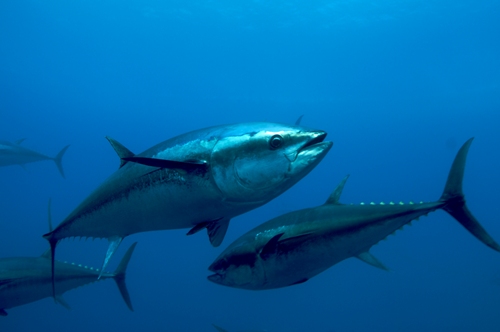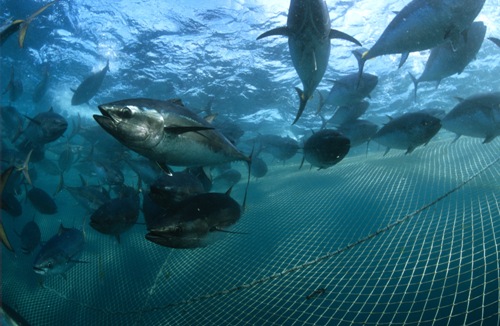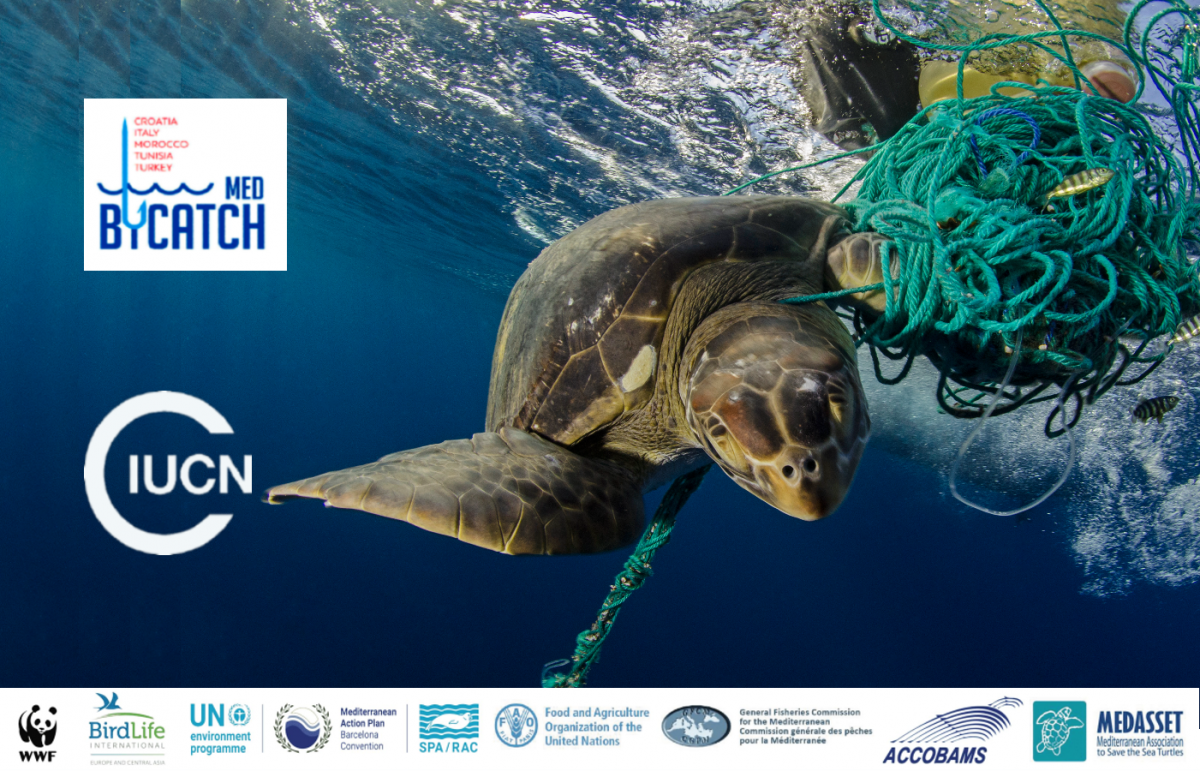Increased protection urgently needed for tunas
For the first time, all species of scombrids (tunas, bonitos, mackerels and Spanish mackerels) and billfishes (swordfish and marlins) have been assessed for the IUCN Red List of Threatened Species™. Of the 61 known species, seven are classified in a threatened category, being at serious risk of extinction. Four species are listed as Near Threatened and nearly two-thirds have been placed in the Least Concern category.
The results show that the situation is particularly serious for tunas. Five of the eight species of tuna are in the threatened or Near Threatened IUCN Red List Categories. These include: Southern Bluefin (Thunnus maccoyii), Critically Endangered; Atlantic Bluefin (T. thynnus), Endangered; Bigeye (T. obesus), Vulnerable; Yellowfin (T. albacares), Near Threatened; and Albacore (T. alalunga), Near Threatened.
This new information will be invaluable in helping governments make decisions which will safeguard the future of these species, many of which are of extremely high economic value, and is a timely input for the 3rd Joint Meeting of the Tuna RFMOs (Regional Fisheries Management Organizations) being held in La Jolla, California, July 11-15.
“This is the first time that fishery scientists, ichthyologists and conservationists have come together to jointly produce an assessment of the threats facing a commercially important group of fishes,” says Dr Bruce B. Collette, Chair of the IUCN Species Survival Commission’s (SSC) Tuna and Billfish Specialist Group, Senior Scientist of NOAA's National Marine Fisheries Service, and lead author of the paper.
There is growing concern that in spite of the healthy status of several epipelagic fish stocks (those living near the surface), some scombrid and billfish species are being heavily overfished, and there is a lack of resolve to protect against overexploitation driven by high prices. Many populations are exploited by multinational fisheries whose regulation, from a political perspective, is exceedingly difficult.
“All three bluefin tuna species are susceptible to collapse under continued excessive fishing pressure. The Southern Bluefin has already essentially crashed, with little hope of recovery,” says Dr Kent Carpenter, Professor at Old Dominion University, manager of IUCN’s Marine Biodiversity Unit and an author of the paper. “If no changes are made to current fishing practices, the western Atlantic Bluefin stocks are at risk of collapse as they are showing little sign that the population is rebuilding following a significant reduction in the 1970s.”
Three species of billfishes are in threatened or Near Threatened categories: Blue Marlin (Makaira nigricans), Vulnerable; White Marlin (Kajikia albida), Vulnerable; and Striped Marlin (Kajikia audax), Near Threatened.
Most of the long-lived economically valuable species are considered threatened. They mature later than short-lived species and their reproductive turnover is longer, and as such recovery from population declines takes more time. As these scombrids and billfishes are at the top of the pelagic food web, population reductions of these predators may cause significant negative effects on other species that are critical to the balance of the marine ecosystem and that are economically important as a source of food.
The future of threatened scombrids and billfishes rests on the ability of RFMOs and fishing nations to properly manage these species. Southern and Atlantic Bluefin populations have been so reduced that the most efficient way to avoid collapse is to shut down the fisheries until stocks are rebuilt to healthy levels. However, this would cause substantial economic hardship and hinder the ability of RFMOs to control fishing because of the increased incentive for illegal fishing that would be created under these circumstances.
“Temporarily shutting down tuna fisheries would only be a part of a much needed recovery programme. In order to prevent illegal fishing, strong deterrents need to be implemented,” says Jean-Christophe Vié, Deputy Director, IUCN’s Global Species Programme. “This new study shows that there is an urgent need for effective management. Scientific findings should not be discarded in order to maintain short-term profit. Marine life and jobs for future generations are both at stake.”
The recovery of fish stocks is possible through reducing fishing-induced mortality rates to well below the maximum sustainable yield (MSY), as shown in the case of the highly valued eastern population of the Atlantic Bluefin. Recently exploited at three times the MSY, a decrease in the total allowable catch and stricter monitoring and compliance measures have led to recent catch reductions of almost 75% over the past few years. This will enable the species to recover to sustainable levels as long as the current fishing controls are maintained.
This new vulnerability assessment includes Bigeye (T. obesus), Yellowfin (T.albacares) and Albacore (T. alalunga), which are of particular importance to the world’s most significant tuna fishing ground, the Pacific. The outcome is expected to leverage current efforts to further tighten management and control of regional tuna stocks.
Catch estimates for 2007 indicated that over 80% of the Pacific tuna catch and 55% of the world tuna catch were taken from the waters of the Western and Central Pacific Ocean (WCPO). The landed value of this catch in 2007 was estimated at USD 3.9 billion.
More than 75% of tuna caught in the WCPO is represented by Skipjack, followed by Yellowfin, Bigeye and Southern Albacore. Currently available data indicate that the biomass of adult Bigeye tuna in the WCPO is at 26% of the level that would be present if fishing was not occurring and has been declining at a steady rate for the past 30 years while Albacore biomass is estimated to be 50%,Yellowfin biomass 51%, and skipjack 66%.
Fisheries policy makers around the globe have been following closely the approach taken by eight Pacific countries that control 25% of the World’s supply of tuna. As ‘Parties to the Nauru Agreement’ (PNA), the Federated States of Micronesia; Kiribati; Marshall Islands; Nauru; Palau; Papua New Guinea; Solomon Islands and Tuvalu, have agreed on a number of measures aiming for sustainable management of their tuna stocks. These include high seas closures, controls on Fish Aggregating Devices (FADs), 100% coverage of purse seine fishing vessels with observers, by-catch regulations and measures and a ‘Vessel Day Scheme’, under which PNA countries agree on a limited number of fishing days for the year, based on scientific advice about the status of the tuna stocks.
“We applaud the efforts of the PNA to manage Tuna stocks in their Exclusive Economic Zones,” ” says Taholo Kami, Regional Director of IUCN’s Oceania Office. “And we call on the Pacific Rim countries and European fishing nations to support these efforts”.
Notes to editors
Copies of the embargoed Science paper “High Value and Long-Lived: Double Jeopardy for Tuna and Billfishes” may be obtained from the AAAS Office of Public Programs.
Please contact +1-202-326-6440 or scipak@aaas.org
Spokespeople available for interviews:
Bruce Collette (in Minneapolis at a meeting but can be contacted on) + 1 612 397 4962; + 1 410 369 8466 (cell) collettb@si.edu
Kent Carpenter (in Philippines) 63-949-313-5649 Kcarpent@odu.edu
Maria Jose Juan Jorda (in Spain) +34-981167000 ext. 2204 + 34-671072900 (cell) mjuanjorda@gmail.com
Beth Polidoro (in Hawaii) + 1 240-446-5183 bpolidor@odu.edu
Bill Fox (in San Diego) +1 202 495 4397 +1 571 205 8845 (Cell) bill.fox@wwfus.org
For further information, please contact:
Lynne Labanne, Species Programme Communications Officer, IUCN, t +41 22 999 0153,
m +41 79 527 7221, e lynne.labanne@iucn.org
Kathryn Pintus, Species Programme Communications, IUCN, t +41 22 999 0154,
e kathryn.pintus@iucn.org
For high resolution photos
Please contact lynne.labanne@iucn.org or Kathryn.pintus@iucn.org
The tuna and billfish assessments
The tuna and billfish assessments are a part of the Global Marine Species Assessment’s mission to complete more than 20,000 marine species assessments for inclusion on the IUCN Red List of Threatened Species. The Global Marine Species Assessment Unit (GMSA), or Marine Biodiversity Unit, is a joint initiative of IUCN and Conservation International. The GMSA is headquartered in the Department of Biology at Old Dominion University in Norfolk, Virginia, and is largely enabled by the generous support of the New Hampshire Charitable Foundation and Tom Haas.
To complete the tuna and billfish IUCN Red List assessments, the GMSA collaborated with a wide diversity of international scientists who represent Fisheries Management Organizations, international conservation organizations; government agencies, universities, and independent fisheries research institutions. IUCN Red List Workshops and finalization of results for tunas and billfishes were made possible by the generous support of Tom Haas and the New Hampshire Charitable Foundation, Conservation International, Lenfest Ocean Program, International Seafood Sustainability Foundation, International Game Fish Association, Instituto Chico Mendes de Conservação da Biodiversidade, Academia Sinica, Taiwan Marine National Park Headquarters, Instituto del Mar del Perú, and CIMAR- University of Costa Rica.
Complete results of the tuna and billfish species assessments will be published on the IUCN Red List of Threatened Species in November 2011. As of July 7, 2011, draft assessments can be found at: http://sci.odu.edu/gmsa/about/tunas_billfishes.shtml
The IUCN Red List threat categories
The IUCN Red List threat categories are as follows, in descending order of threat:
Extinct or Extinct in the Wild
Critically Endangered, Endangered and Vulnerable: species threatened with global extinction
Near Threatened: species close to the threatened thresholds or that would be threatened without ongoing specific conservation measures
Least Concern: species evaluated with a lower risk of extinction
Data Deficient: no assessment because of insufficient data
Critically Endangered (Possibly Extinct): this is not a new IUCN Red List Category, but is a flag developed to identify those Critically Endangered species that are in all probability already Extinct but for which confirmation is required, for example, through more extensive surveys being carried out and failing to find any individuals.






